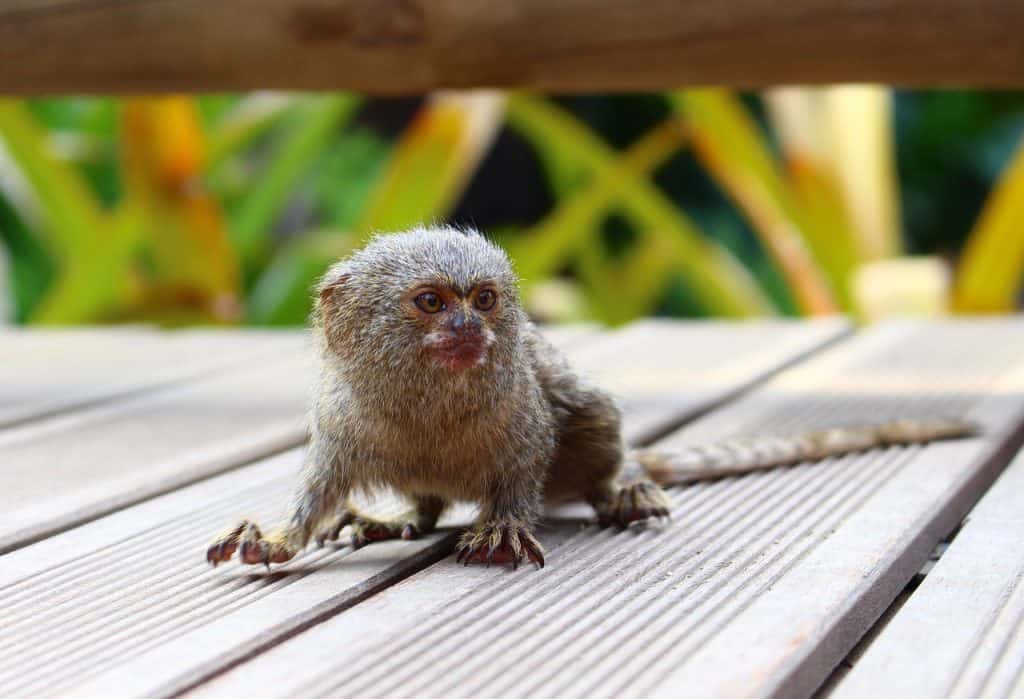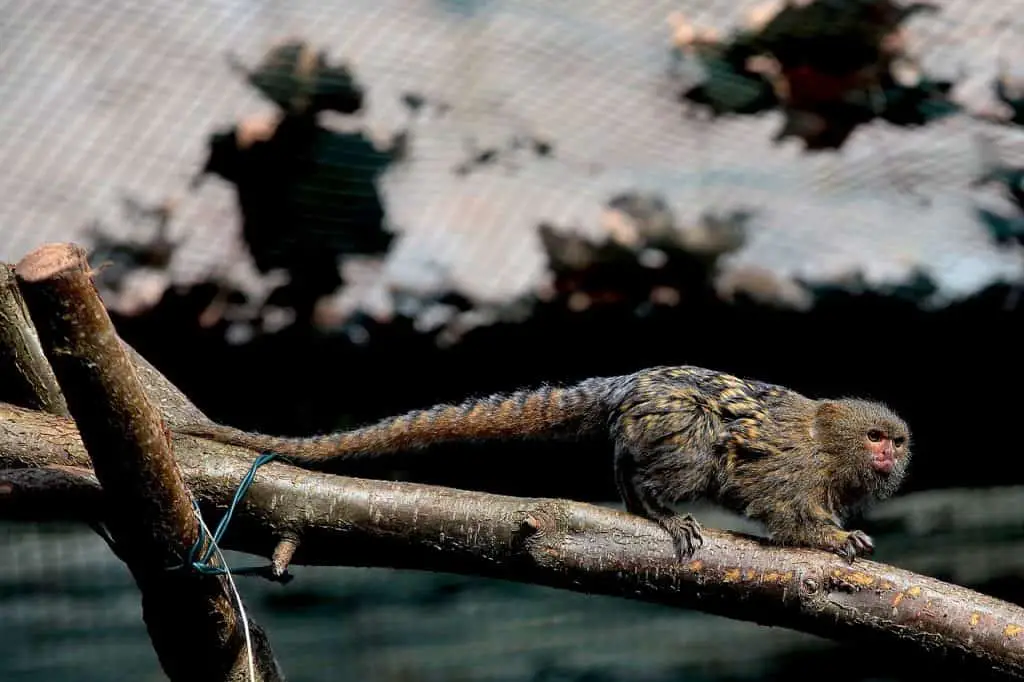Let’s just admit it. Anything that comes in miniature is automatically cuter than the regular size. For example, puppies are arguably cuter than full-grown dogs. But the logic applies to animals around the globe. Enter finger monkeys!
Finger monkeys live up to the name, you can fit these adorable little primates in your pocket. You’ll learn everything you want to know about finger monkeys below.
What are finger monkeys?

Finger monkeys go by many names, including pygmy marmoset, thumb monkeys, or pocket monkeys. These adorable creatures earned their popular nickname due to their incredibly small size.
They are considered the smallest primates in the world, making them an object of curiosity and fascination for wildlife enthusiasts and researchers alike.
Pocket monkey: Scientific classification
- Kingdom: Animalia
- Phylum: Chordata
- Class: Mammalia
- Order: Primates
- Suborder: Haplorhini
- Infraorder: Simiiformes
- Family: Callitrichidae
- Genus: Cebuella
- Species: Cebuella pygmaea
Finger monkeys: Physical features
Size: Adults are around 5 to 6 inches long!

Adult finger monkeys typically measure around 5-6 inches (13-15 cm) in length and weigh a mere 3-5 ounces (85-140 grams). Their bodies are covered in soft, dense fur that can vary in color from shades of brown, gray, or black, often with striking patterns or markings on their faces.
One of the distinctive features of finger monkeys is their long, slender tails, which can measure up to twice the length of their bodies. These tails serve as a balancing tool as they skillfully navigate the intricate branches of their rainforest habitat. Their hands and feet are equipped with sharp, curved claws that aid in gripping and climbing trees with remarkable agility. Their large, expressive eyes provide excellent vision, allowing them to spot predators or locate food sources within the dense foliage.
Facts about finger monkeys
- Finger monkeys are the smallest primates in the world, with adults measuring around 5-6 inches (13-15 cm) in length.
- These tiny primates are highly skilled climbers and spend the majority of their lives in the treetops, leaping and swinging from branch to branch with their long tails and nimble fingers.
- Unlike many other primate species, pocket monkeys form monogamous pairs, consisting of a breeding male and female who share parental responsibilities in raising their offspring.
- Finger monkeys play an important ecological role in their natural habitats as seed dispersers, helping to promote forest regeneration by spreading seeds through their feeding and movement patterns.
- Contrary to what you might see on the internet, finger monkeys aren’t ideal pets. Remember, these are wild animals. Bringing them into captivity isn’t easy for them to adjust to.
Finger monkey life cycle
Life span: 12 to 20 years
The tiny primates have a relatively short life span compared to larger primates, but they make the most out of their time in the rainforest canopy.
Gestation
After a gestation period of approximately 140-145 days, the female gives birth to usually twins, sometimes triplets.
Newborn
The newborn finger monkeys are incredibly small, weighing just a few grams at birth. They are completely dependent on their parents for care and nourishment. The mother carries them clinging to her belly or back, ensuring their safety and providing constant warmth and protection.
Juvenile
As finger monkey infants grow, they start to explore their surroundings within the safety of their family group. They learn valuable skills such as climbing and foraging under the guidance of their parents. The young finger monkeys receive nourishment from their mother’s milk, and as they mature, they gradually transition to solid food, including tree sap, gum, insects, and fruits.
Maturity
With each passing month, the pocket monkeys gain independence and become more proficient in their abilities. By the time they reach adulthood, which usually occurs around one year of age, they are ready to contribute to the social dynamics of their family group. As adults, they participate in breeding activities, establish their own territories, and play a role in raising the next generation of finger monkeys.
Finger Monkey Behaviors
Throughout their life cycle, finger monkeys prioritize social bonding and exhibit strong family ties. The close-knit family groups serve as a support system, ensuring the survival and success of each individual.
Social structure: A deeper look
Pygmy marmosets exhibit a fascinating social structure that plays a vital role in their daily lives and overall survival. These small primates are highly social animals, relying on strong family bonds and cooperative behaviors within their social groups.
The core of finger monkey social structure revolves around the family unit. Family groups typically consist of a breeding pair, which forms a monogamous bond, and their offspring. This pair bond is crucial for maintaining group cohesion and ensuring the successful raising of young. Both the male and female actively participate in parenting duties, including carrying and grooming the infants, and sharing the responsibility of protecting and nurturing the young finger monkeys.
Within the family group, various social interactions take place. Mutual grooming is a common behavior, where individuals groom one another to strengthen social bonds and establish trust. Vocalizations also play a significant role in communication, with finger monkeys producing a range of calls, trills, and chirps to convey messages such as warnings, territorial claims, or calls for assistance.
While finger monkeys primarily live in family groups, they can also form larger social units called troops. These troops may consist of multiple family groups that come together, interacting and foraging as a collective unit. This troop structure provides additional protection and support, allowing for cooperative behaviors in activities such as predator defense and resource acquisition.
Finger Monkey Habitat
Finger monkeys primarily inhabit the tropical rainforests of the Amazon basin, including countries such as Brazil, Peru, Ecuador, and Colombia. These forests provide the ideal environment for their arboreal lifestyle, with an abundance of trees, vines, and foliage that allow them to move swiftly and adeptly in the treetops. Their nimble fingers, sharp claws, and long tails are perfectly suited for navigating the intricate branches and swinging from tree to tree.
Within their rainforest habitat, pocket monkeys display a preference for specific microhabitats. They are commonly found in areas with dense canopy cover, where they can find shelter and protection from predators. They are also associated with areas near water sources, such as rivers or streams.
Diet
Pocket monkeys are omnivorous, meaning they consume a combination of plant matter and small animal prey. Their diet primarily consists of tree sap, gum, nectar, fruits, and insects. One of their remarkable adaptations is their ability to access tree sap by gnawing on tree bark. Their specialized teeth enable them to create small holes in the bark, allowing them to feed on the sap that flows within. This sap provides them with essential carbohydrates and nutrients.
In addition to sap and gum, pocket monkeys have a sweet tooth for nectar and fruits. They feed on the nectar of various flowers, using their long tongues to extract the sugary liquid. Fruits, such as berries and small fruits, make up an important part of their diet as well. These provide them with additional nutrients, vitamins, and minerals.
To supplement their plant-based diet, finger monkeys also include insects in their meals. They feed on small insects, such as ants, beetles, and spiders, which serve as a valuable source of protein. Their nimble fingers and sharp claws aid in capturing and manipulating these tiny prey items.
Threats to finger monkeys
Finger monkeys, like most other wildlife on this planet, are facing human-induced challenges to their survival.
One of the primary threats to finger monkeys is habitat loss. The destruction of their rainforest habitat due to deforestation, primarily driven by logging, agriculture, and urban expansion, is a major concern. As vast areas of forests are cleared, finger monkeys lose their essential food sources, shelter, and the interconnected web of plant and animal species that make up their ecosystem.
Additionally, human activities such as illegal wildlife trade pose a significant threat to finger monkeys. These adorable primates are often targeted for the exotic pet trade, leading to their capture and removal from their natural habitats. The illegal pet trade not only disrupts their social structure but also reduces their wild populations, as individuals are taken from the wild without proper regulation or consideration for their well-being.
Finger monkey conservation efforts
Conservation efforts focused on the forests that the finger monkey inhabits are underway. Additionally, some captivity-based conservation efforts are happening. For example, Florida International University participates in the Lion Tamarin Conservation Program, which is focused on protecting wild finger monkeys.
One way you can help is by resisting the temptation to buy yourself a finger monkey as a pet. While these animals are undeniably adorable, they can lead their best lives in the wild.
How to see a finger monkey
Finger monkeys are found throughout the Amazon. If you are planning a trip to the Amazon, you might be lucky enough to see one of these beautiful creatures in person. And, of course, some zoos have finger monkeys living in captivity, which you can see up close.
Avoid getting a finger monkey as a pet just to see one. You can see one at a nearby zoo, or possibly get lucky in the wild!
Frequently asked questions
Here are the answers to questions people often have about pocket monkeys.
Are finger monkeys endangered?
Finger monkeys, also known as pygmy marmosets, are not currently classified as endangered. However, they do face threats due to habitat loss and the illegal pet trade. Conservation efforts and sustainable practices are crucial to ensuring their long-term survival in their natural habitats.
Do finger monkeys live in groups?
Yes, pocket monkeys are highly social animals. They live in close-knit family groups consisting of a breeding pair and their offspring. They engage in mutual grooming, communicate through vocalizations, and rely on their family structure for support and protection.
Can finger monkeys be kept as pets?
Pocket monkeys are not recommended as pets for several reasons. They have specific care requirements and social needs that can be challenging to meet in a domestic setting. Furthermore, the capture and trade of finger monkeys as pets contribute to their decline in the wild. It is important to support conservation efforts and admire these primates in their natural habitats.
What do finger monkeys eat?
Finger monkeys have an omnivorous diet. They primarily feed on tree sap, gum, nectar, fruits, and insects.
Final take on Finger Monkeys
Finger monkeys are adorable creatures. But they have more to offer than their cute face. The minuscule monkeys lead an interesting life in their treetop home. Notably, these wild monkeys have a complex social structure that dictates their daily life. It’s a wonder to watch!
